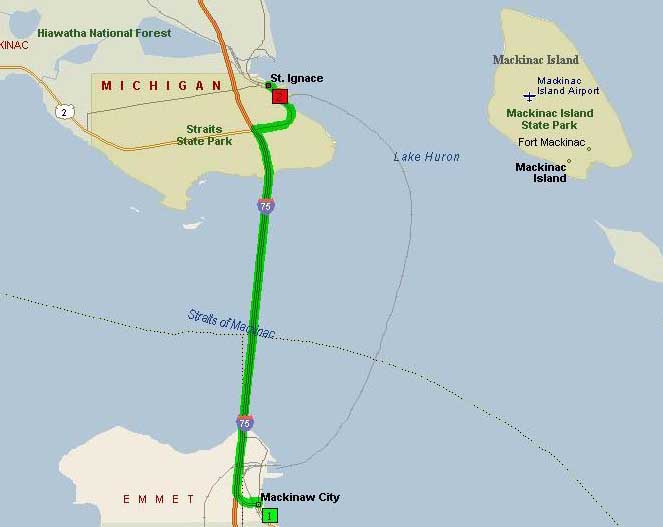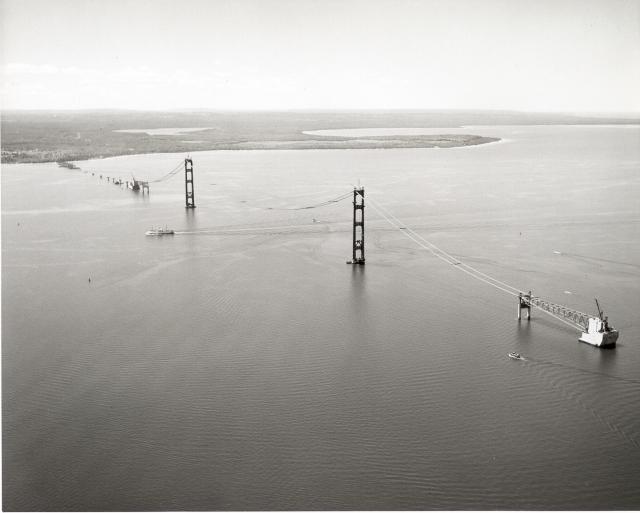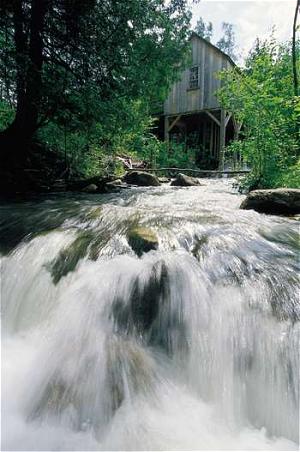MACKINAC CITY AND ST. IGNACE

Source: Unknown

Source: Unknown
Mackinaw City and St. Ignace are separated by the Straights of Mackinac, but are connected by the Mackinac Bridge. To get from one point to the next, you can travel across the Mackinac Bridge, which and opened to the public on November 1, 1957. The bridge is 5miles long, and the average price of a round-trip ticket is approximately $5.[1]

Source: Unknown
Mackinaw City was first settled in 1681 and used by traders, missionaries, and explorers. The city is known for its famous fort named Fort Michilimackinac. The fort was originally used for trading purposes. Because the British felt that the fort was not practical in cases of invasion, the moved to Mackinac Island and created a new fort, Fort Mackinac. Today, tourists can visit Fort Michilimackinac and watch reenactments. Currently, park admission is $9.50/adult and $6/child, with the fort being open from May until October with varying hours. [2]

The Old Mackinac Point Lighthouse was in operation from 1892-1957 and its sole purpose was to guide ships through the Straights of Mackinac. The structure looks as if it were a castle, and today tourists can visit the site to watch ongoing restoration and exhibits. Along with the entrance fee, you can climb the four stories via stairs and a ladder to reach the top. The cost of admission is $6 and $3.50 for adults and children respectively. [3]

Source: Unknown
After much research and excavation, it was discovered that inhabitants resided at Mill Creek from the 1780s until approximately 1845.[4] The community had a close connection with Mackinac Island and was a water-powered sawmill. It was one of the first industrial sites in the Great Lakes region, and today visitors can venture around the scenic site. To visit the sawmill, prices range from $7.50/adult to $4.50/child. [5]
Father Jacques Marquette founded the mission of St. Ignace in 1671 in hopes to spread the Christian message to Indians residing in that region. In 1877, Father Marquette�s remains were discovered in St. Ignace and were reburied in the chapel at the site of the mission. Along with the historic chapel, the Father Marquette National Memorial is also located in St. Ignace. There is no cost for admission, as the site is open with picnic, camping, and recreation areas along with the memorial.[6]

Source: Image Courtesy of Erin Muldowney, former GEO 333 student
Mackinaw City and St. Ignace have a lot to offer in the way of tourism attractions and historical sites. History has a real stronghold in the two locations, and people are encouraged to visit with family and friends. Prices are relatively cheap, and there are packages that include admission for several of the historical parks in Mackinaw City and some on the Island. For more information, please visit project..mackinacparks.com .
REFERENCES
[1] project..mackinacbridge.org/
[2] project..michigan.gov/hal/0,1607,7-160-17449_18638_20846-54583--,00.html
[3] project..mackinacparks.com/parks/old-mackinac-point-lighthouse_11/
[4] Armour, David A. 100 Years at Mackinac. Mackinac State Historic Parks, MI, 1995.
[5] project..mackinacparks.com/parks/historic-mill-creek-facts_46/
[6] project..michigan.gov/hal/0,1607,7-160-17449_18638_20846-54630--,00.html
Page created by Erin Muldowney, a GEO 333 student
This material has been compiled for educational use only, and may not be reproduced without permission. One copy may be printed for personal use. Please contact Randall Schaetzl (soils@msu.edu) for more information or permissions.